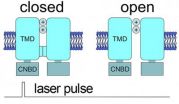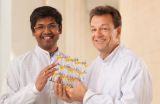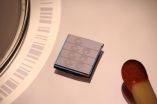(Press-News.org) One of the great problems in physics is the detection of electromagnetic radiation – that is, light – which lies outside the small range of wavelengths that the human eye can see. Think X-rays, for example, or radio waves.
Now, researchers have discovered a way to use existing semiconductors to detect a far wider range of light than is now possible, well into the infrared range. The team hopes to use the technology in detectors, obviously, but also in improved solar cells that could absorb infrared light as well as the sun's visible rays.
"This technology will also allow dual or multiband detectors to be developed, which could be used to reduce false positives in identifying, for example, toxic gases," said Unil Perera, a Regents' Professor of Physics at Georgia State University. Perera leads the Optoelectronics Research Laboratory, where fellow author and postdoctoral fellow Yan-Feng Lao is also a member. The research team also included scientists from the University of Leeds in England and Shanghai Jiao Tong University in China.
To understand the team's breakthrough, it's important to understand how semiconductors work. Basically, a semiconductor is exactly what its name implies – a material that will conduct an electromagnetic current, but not always. An external energy source must be used to get those electrons moving.
But infrared light doesn't carry a lot of energy, and won't cause many semiconductors to react. And without a reaction, there's nothing to detect.
Until now, the only solution would have been to find a semiconductor material that would respond to long-wavelength, low-energy light like the infrared spectrum.
But instead, the researchers worked around the problem by adding another light source to their device. The extra light source primes the semiconductor with energy, like running hot water over a jar lid to loosen it. When a low-energy, long-wavelength beam comes along, it pushes the material over the top, causing a detectable reaction.
The new and improved device can detect wavelengths up to at least the 55 micrometer range, whereas before the same detector could only see wavelengths of about 4 micrometers. The team has run simulations showing that a refined version of the device could detect wavelengths up to 100 micrometers long.
Edmund Linfield, professor of terahertz electronics at the University of Leeds, whose team built the patterned semiconductors used in the new technique, said, "This is a really exciting breakthrough and opens up the opportunity to explore a wide range of new device concepts including more efficient photovoltaics and photodetectors."
Perera and Lao have filed a U.S. patent application for their detector design.
INFORMATION:
"Tunable hot-carrier photodetection beyond the band-gap spectral limit" by Yan-Feng Lao, A.G. Unil Perera, L.H. Li, S.P. Khanna, E.H. Linfield and H.C. Liu is in the May issue of Nature Photonics.
The work was supported by the U.S. Army Research Office, the U.S. National Science Foundation, the UK Engineering and Physical Sciences Research Council, and the European Research Council Advanced Grant "TOSCA."
New 'tunable' semiconductors will allow better detectors, solar cells
2014-04-14
ELSE PRESS RELEASES FROM THIS DATE:
A stable model for an unstable target
2014-04-14
A study in The Journal of General Physiology provides new insights about singlet oxygen and sets the stage for better understanding of this highly reactive and challenging substance.
Singlet oxygen is an electronically excited state of oxygen that is less stable than normal oxygen. Its high reactivity has enabled its use in photodynamic therapy, in which light is used in combination with a photosensitizing drug to generate large amounts of singlet oxygen to kill cancer cells or various pathogens.
Light-generated singlet oxygen also plays a role in a range of biological ...
Better solar cells, better LED light and vast optical possibilities
2014-04-14
Changes at the atom level in nanowires offer vast possibilities for improvement of solar cells and LED light. NTNU-researchers have discovered that by tuning a small strain on single nanowires they can become more effective in LEDs and solar cells.
NTNU researchers Dheeraj Dasa and Helge Weman have, in cooperation with IBM, discovered that gallium arsenide can be tuned with a small strain to function efficiently as a single light-emitting diode or a photodetector. This is facilitated by the special hexagonal crystal structure, referred to as wurtzite, which the NTNU ...
Pioneering findings on the dual role of carbon dioxide in photosynthesis
2014-04-14
Scientists at Umeå University in Sweden have found that carbon dioxide, in its ionic form bicarbonate, has a regulating function in the splitting of water in photosynthesis. This means that carbon dioxide has an additional role to being reduced to sugar. The pioneering work is published in the latest issue of the scientific journal PNAS.
It is well known that inorganic carbon in the form of carbon dioxide, CO2, is reduced in a light driven process known as photosynthesis to organic compounds in the chloroplasts. Less well known is that inorganic carbon also affects the ...
The result of slow degradation
2014-04-14
This news release is available in German. Although persistent environmental pollutants have been and continue to be released worldwide, the Arctic and Antarctic regions are significantly more contaminated than elsewhere. The marine animals living there have some of the highest levels of persistent organic pollutant (POP) contamination of any creatures. The Inuit people of the Arctic, who rely on a diet of fish, seals and whales, have also been shown to have higher POP concentrations than people living in our latitudes.
Today, the production and use of nearly two dozen ...
Nutrient-rich forests absorb more carbon
2014-04-14
The ability of forests to sequester carbon from the atmosphere depends on nutrients available in the forest soils, shows new research from an international team of researchers including the International Institute for Applied Systems Analysis (IIASA).
The study showed that forests growing in fertile soils with ample nutrients are able to sequester about 30% of the carbon that they take up during photosynthesis. In contrast, forests growing in nutrient-poor soils may retain only 6% of that carbon. The rest is returned to the atmosphere as respiration.
"This paper produces ...
Scientists open door to better solar cells, superconductors and hard-drives
2014-04-14
Using DESY's bright research light sources, scientists have opened a new door to better solar cells, novel superconductors and smaller hard-drives. The research reported in the scientific journal Nature Communications this week enhances the understanding of the interface of two materials, where completely new properties can arise. With their work, the team of Prof. Andrivo Rusydi from the National University of Singapore and Prof. Michael Rübhausen from the Hamburg Center for Free-Electron Laser Science (CFEL) have solved a long standing mystery in the physics of condensed ...
Combs of light accelerate communication
2014-04-14
This news release is available in German.
Miniaturized optical frequency comb sources allow for transmission of data streams of several terabits per second over hundreds of kilometers – this has now been demonstrated by researchers of Karlsruhe Institute of Technology (KIT) and the Swiss École Polytechnique Fédérale de Lausanne (EPFL) in a experiment presented in the journal Nature Photonics. The results may contribute to accelerating data transmission in large computing centers and worldwide communication networks. (DOI: 10.1038/NPHOTON.2014.57.)
The amount of ...
Proteomics International biomarker study closer to a CDx test for diabetic kidney disease
2014-04-14
April 2014, Perth, Australia. Drug discovery company Proteomics International has completed an important milestone towards the development of a companion diagnostic (CDx) test with the validation of several of its protein biomarkers.
The research team authenticated the panel of biomarkers after taking 508 highly curated disease and control samples. Seven biomarkers were validated at high stringency using the company's proprietary mass spectrometry approach.
The mass spectrometry data was then cross-validated using immunoassays in collaboration with the KTH Royal Institute ...
Beneficial organisms react differently to parasite drug
2014-04-14
The substance ivermectin has been used for more than thirty years all over the world to combat parasites like roundworms, lice and mites in humans, livestock and pets. The active ingredient belongs to the chemical group of avermectins, which generally disrupt cell transport and thus attack pests. When ivermectin is excreted in the faeces of treated animals, at overly high doses it also harms dung-degrading beneficial insects like dung beetles and dung flies. This impairs the functioning of the ecosystem. In extreme cases the dung is not decomposed and the pasture is destroyed.
Sensitivity ...
Does germ plasm accelerate evolution?
2014-04-14
Scientists at The University of Nottingham have published research in the leading academic journal Science that challenges a long held belief about the way certain species of vertebrates evolved.
Dr Matt Loose and Dr Andrew Johnson who are experts in genetics and cell development in the School of Life Sciences carried out the research, funded by the Medical Research Council (MRC). It suggests that genes evolve more rapidly in species containing germ plasm. The results came about as they put to the test a novel theory that early developmental events dramatically alter ...


